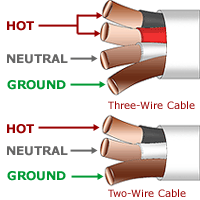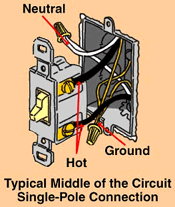You don't have to be an electrician to replace a light fixture. Many homeowners are afraid to tackle electrical projects—and rightly so. If improperly handled, electricity poses electrocution and fire hazards. But simple jobs like light fixture replacements are easy and safe if you follow a few simple rules. Lowe's is happy to provide this information as a service to you.
The most basic principles of the wiring in your home are simple. The following is elementary information from which every homeowner can benefit:
- In contemporary wiring, individual wires run in a sheathed cable. "Two-wire with ground" and "three-wire with ground" cables are available. Two-wire with ground cables have a black wire, a white wire and an uninsulated ground. Three-wire with ground cables have a black wire, a white wire, a red wire and an uninsulated ground. Older houses may have "knob and tube" wiring—a two-wire system. With this system, individual wires are insulated with white or black treated fabric.
- Regardless of the type of wiring in your home, the white wire is usually the neutral wire, the black wire is "hot," and the exposed copper wires are ground wires. The white wire is sometimes used as a hot wire because some wiring installations require it. In this case, the white wire should be coded black with paint or electrical tape. Note, however, that it is possible that whoever did the wiring may not have coded the wire. If a red wire is present, it should also be hot.
 Switches may be wired at the end or in the middle of a circuit. If only a single cable enters the box (or one set of black and white wires), the fixture is at the end of the circuit. This is usually, but not always, the situation with ceiling light fixtures. If two cables enter the box (or two sets of black and white wires in older "knob and tube" installations), the fixture is in the middle of a circuit. A third cable (or set of black and white wires) may also enter the fixture, depending upon the installation. The placement of the fixture within the circuit affects how it is wired.
Switches may be wired at the end or in the middle of a circuit. If only a single cable enters the box (or one set of black and white wires), the fixture is at the end of the circuit. This is usually, but not always, the situation with ceiling light fixtures. If two cables enter the box (or two sets of black and white wires in older "knob and tube" installations), the fixture is in the middle of a circuit. A third cable (or set of black and white wires) may also enter the fixture, depending upon the installation. The placement of the fixture within the circuit affects how it is wired.
- The black, or hot wires, are connected to the brass screw terminals on receptacles and switches. The neutral wires are connected to the silver terminals. Ground wires should not be ignored. They should be connected to each other, to the grounding screw terminals (painted green) on receptacles, and to grounding screws in metal electrical boxes when metal boxes are used.

- Pigtail leads are short wires which are connected to terminals on receptacles or switches. The leads are then connected to the home wiring using plastic wire connectors. Codes in some areas require that pigtails be used on all standard receptacle connections. Always use pigtails when more than one wire must be connected to a single terminal.
| What If Your House Has Aluminum Wiring? It is easy to tell if your home has aluminum wiring—the metal under the insulation is almost white instead of copper colored. Aluminum and copper wires should be connected with a wire connector specifically rated for this purpose. Otherwise, copper and aluminum will react with each other, possibly leading to a loose connection and creating a fire hazard. |
Was this information helpful? Please let us know your do-it-yourself experiences. We'd love to hear from you!
These How-To's are provided as a service from Lowe's, the Original Home Improvement Warehouse of How-To information for the World Wide Web. The information in Lowe's "How-To" clinics is intended to simplify jobs around the house. Tools, products, materials, techniques, building codes and local regulations change; therefore, Lowe's assumes no liability for omissions, errors or the outcome of any project. The reader must always exercise reasonable caution, follow current codes and regulations that may apply, and is urged to consult with a licensed professional if in doubt about any procedures.
No comments:
Post a Comment